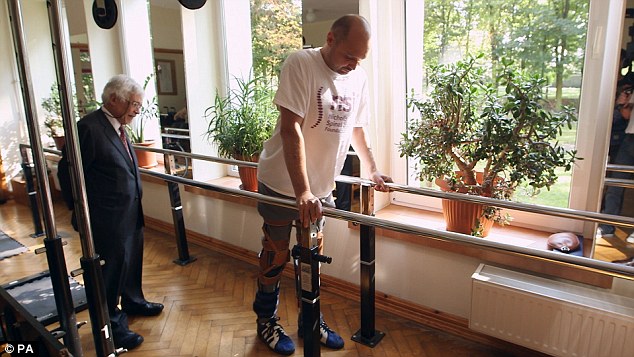Cell Transplant Enables Paralysed Man To Walk
Posted on October 24, 2014 by Jamie Slaughter, with 9751 views

Paralysed from the chest down after a brutal knife attack in 2010, Darek Fidyka was left with an 8mm gap in his spinal colum. With the help from scientists in London, surgeons in Poland have given Fidyka the opportunity to walk again, thanks to a joint effort into a new procedure using cell transplants from his olfactory bulbs.
Darek's injuries were so severe that no level of therapy could give him feeling back into his legs. After two years of extensive research and treatment, Fidyka finally recovered some feeling in his legs, feet, bowels, bladder and can now walk, albeit with assistance.
The scientists behind this treatment first extracted one of Fidyka's olfactory bulbs, before proceeding to grow external olfactory ensheathing cells and attach them onto his damaged spine. This process allowed nerve fibers to be linked back together and feeling to gradually come back.
The OEC's act as intermediary cells which repair and renew damaged nerve fibers. 100 micro injections were made around the affected area, and four thin layers of nerve tissue from Fidyka's ankle were attached to the damaged region. Three months passed before the medical experts began to notice muscle mass developing on his left thigh. Another three months elapsed after which Fidyka was able to stand and take his first minor, yet groundbreaking, steps. Fidyka is currently undergoing 5 hours of physiotherapy, 5 days every week
"It is immensely gratifying to see that years of research have now led to the development of a safe technique for transplanting cells into the spinal cord." said Professor Geoff Raisman, Chairman of Neural Regeneration at UCL Institute of Neurology. "I believe we stand on the threshold of a historic advance and that the continuation of our work will be of major benefit to mankind. I believe we have now opened the door to a treatment of spinal cord injury that will get patients out of wheel chairs. Our goal now is to develop this first procedure to a point where it can be rolled out as a worldwide general approach."
BBC Panorama asked what it felt like to be given this opportunity to walk again, Fidyka said, "when you can't feel almost half your body, you are helpless, but when it starts coming back it's as if you were born again."
The treatment is the first successful case of cell transplant and paralysis reversal, and this exciting result will hopefully ripple through the world and bring feeling back to many who thought they would never experience it ever again.
Details of the research can be found in the journal Cell Transplantation.

Add Comment
1 Comments
Jake from statefarm
Submitted by Jake From